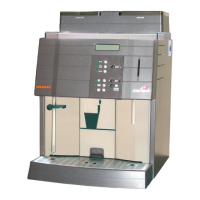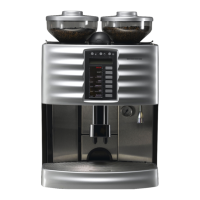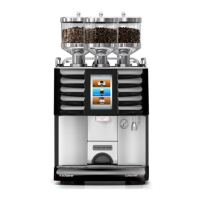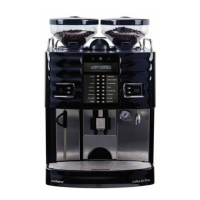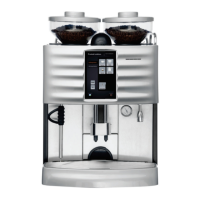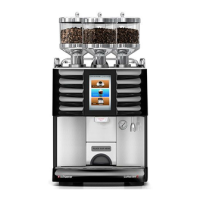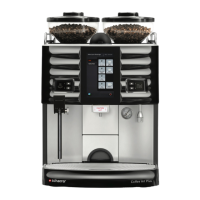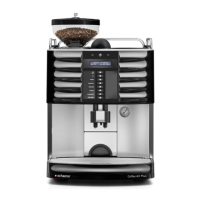Chapter 3 Functional descriptions
64 SMSO-2-02.03- 15.07.03
3.3 Refrigerator (optional feature)
The refrigerator option consists of a small refrigerator in which
milk is kept and the dosing and cleaning unit for the serving of
milk. The milk can be served as a product on its own (hot
milk). However, it is also possible to serve milk foam to sup-
plement other products from the coffee machine (such as
cappuccinos for example). The refrigerator is fully integrated
into the coffee machine as regards the control system and
accounting. It therefore does not require separate control
components, or separate supply or disposal elements.
Function
General
As a natural product milk is a very awkward product to handle
in dosing and filling systems. The various dynamic character-
istics (viscosity) caused by its fat content , its temperature and
its storage time in “semi-opened” containers makes extremely
high demands on the technical equipment and on hygiene
measures. In unfavourable conditions (such as temperatures
over 5
o
C, open air infeed, unsuitable container material) milk
has a rapid tendency to ferment (i.e. coagulate into a cheese-
like mass). This coagulated mass will very quickly be covered
in mildew if the unfavourable conditions continue.
By selecting suitable materials and using simply shapes for
the dosing and outlet components suitable for pouring liquids,
these disadvantages can be eliminated to a degree. However,
the design is of use only when the system is operated in con-
ditions of absolute hygiene.
The main components of the refrigerator are the insulated
cabinet housing with the integral evaporator and temperature
sensor. The compressor is located on the cabinet, together
with the cooling unit and the ventilator.
A refrigerant with a low evaporation point circulates within the
closed cooling system. The compressor extracts refrigerant
from the evaporator; under-pressure occurs in the evaporator.
The cooling system and capillary tube are located between the
compressor and the evaporator. These place a considerable
resistance against the flow of refrigerant. The temperature of
the refrigerant is raised to approximately 120
o
C by compres-
sion. The heat is dissipated to the ambient air inside the cool-
ing unit (heat exchanger) and the refrigerant condenses (be-
comes fluid). A ventilator ensures that there is sufficient air
flow for the cooling operation.
The refrigerant flows into the filter drier at the end of the capil-
lary tube. Here it is filtered and any residual moisture is fixed.
It reaches the evaporator from the filter drier. Due to the un-
der-pressure that is in effect here, and the larger cross-section
of pipe (volume) the refrigerant can expand; it evaporates. The
necessary evaporation heat is thus drawn from the refriger-
ated product inside the refrigerator (i.e. from the milk). Once it
has flowed through the evaporator, the refrigerant goes back
to the compressor. The refrigerant circuit is thus closed. The
temperature is controlled by a thermostat that measures the
temperature of the cooling area.
Refrigerator
1 Housing
2 Compressor (with motor)
3 Cooling unit (heat exchanger)
4 Capillary tube
5 Evaporator
6 Temperature sensor
7 Switch-on relay
8 Ventilator
Drawing symbol
Illustration
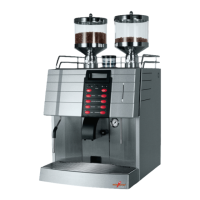
